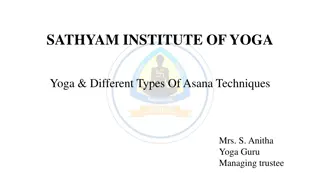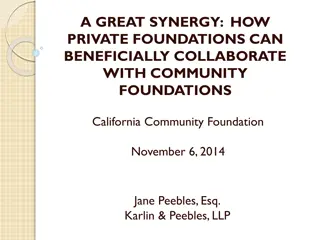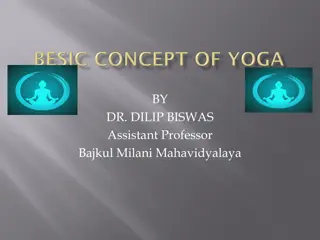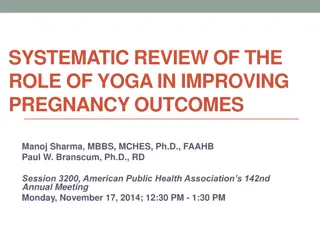The 8 Limbed Path of Yoga: Foundations and Practices
The 8 Limbed Path of Yoga, as outlined by Patanjali, offers a comprehensive guide to ethical living and spiritual growth through practices such as Yamas (external restraints) and Niyamas (internal restraints). These limbs include principles for personal conduct, physical postures, breath regulation, withdrawal of senses, concentration, meditation, absorption, and integration. Emphasizing ethics, self-examination, and relationship navigation, this path leads towards a deeper understanding of oneself and the world.
Download Presentation

Please find below an Image/Link to download the presentation.
The content on the website is provided AS IS for your information and personal use only. It may not be sold, licensed, or shared on other websites without obtaining consent from the author.If you encounter any issues during the download, it is possible that the publisher has removed the file from their server.
You are allowed to download the files provided on this website for personal or commercial use, subject to the condition that they are used lawfully. All files are the property of their respective owners.
The content on the website is provided AS IS for your information and personal use only. It may not be sold, licensed, or shared on other websites without obtaining consent from the author.
E N D
Presentation Transcript
1. Yamas (external restraints): the clarification of ones relationship to the world of people and objects. There are five practices associated with this limb Ahi s (not harming, nonviolence) Satya (honest, being truthful) Astrya (not stealing) Brahmacharya (wise use of energy) Aparigraha (not being acquisitive)
2. Niyamas (internal restraints): personal principles governing the cultivation of insight Sauca (purification) Santosa (contentment) Tapas (discipline, patience) Sv dhy ya (self-study, contemplation) Isvara-pranidh n (devotion)
3. sana (posture): cultivation of physical and psychological steadiness and ease in mind, breath and body sthira-sukham- sanam 4. Pr n yama (breath and energy regulation): bringing about a natural refinement of the mind-body process through the calming of the respiratory process
5. Pratyahara (withdrawing of the senses): a naturally occurring uncoupling of the sense organs and sense objects as awareness interiorizes 6. Dharana (concentration meditation): locking awareness on a single object (such as sound, breath, sensation in the body) until the field of awareness becomes singular and focused 7. Dhyana (absorption): concentration deepens to the point where subject and object dissolve 8. Samadhi (integration): the sustained experience of concentration, in which there is complete integration of subject and object, revealing pure awareness as the nondual substratum of reality, no- seperation
Yamas - Ethics The foundation of the spiritual path of Patanjalis yoga is ethics a set of suggestion for how to live The yamas encourage us towards an honest examination and transformation of our physical actions and interpersonal relationships For many of us, it is the world of relationships that bring up our deepest holding patterns and reactions The Yamas offer a guide of how to navigate relational experience
In many ways the 8 limbed path encourages us away from a self-centred view of the world The foundation of ethics keeps us grounded in the world of relationships The yamas refer not just to our external relationships, but also to how we relate to our internal states as well We practice the yamas in relation to body, speech and mind, and in our relations with ourselves and others
Ahis Non Violence ahimsa pratisthayam tat vaira-tyaga In the presence of one firmly established in non violence, all hostilities cease Sutra 2:35 Offers a framework for both guiding and reflecting on our thoughts and actions Non-harming towards the bodies of others, and our own body Non-harming in both how we speak and listen to others, and in how we speak and listen to ourselves Thoughts the seeds which when watered often enough sprout into actions Second Darts An essential component of non-harming is the cultivation of compassion
Satya Satya Honesty Honesty pratisthayamkriya satya satyapratisthayam kriya phala phala ashrayatvam ashrayatvam Firm establishment in truthfulness results in fruition of (truthful) action. Sutra 3.36 To speak and reflect on our own actions and situations as truthfully as we can Accountability To have integrity in our relationships with others To be honest with ourselves (and others) about our own capabilities, which can create the foundations for progress and improvement
Asteya Asteya Non Stealing Non Stealing asteya pratisthayam sarva ratna upasthanam asteya pratisthayam sarva ratna upasthanam When firmly established in non-stealing (asteya), all is jewels Sutra 2.37 Literal translation of Asteya is not taking what is not freely given As a practice, non-stealing, like all the other yamas, orientates us towards the transparency of all things and their interrelationship How much are we taking time, space, freedom, energy, attention? Stealing, in all it forms, is often the product of an unsettled, unsatisfied mind
Brahmancharya Brahmancharya Wise Use of Energy Wise Use of Energy brahmacharya pratisthayam virya labha brahmacharya pratisthayam virya labha When firmly established in constant presence of the Divine, sexual continence or chastity, vitality is gained Sutra 2.38 Traditional interpretation is celibacy Can also be seen as encouraging the wise use of sexual energy Every encounter between people, particularly sexual encounters, creates a new kind of relationship Brahmancharya encourages us to reflect on what kind of relationships this energy creates, and how that will impact on ourselves and others
Aparigraha Aparigraha Non Aquisitiveness Non Aquisitiveness aparigraha sthairye janma kathanta sambodha aparigraha sthairye janma kathanta sambodha Permanent stability in non-possessiveness arises perfect knowledge and understanding of birth(s) and incarnations Sutra 2.39 Word comes from the root grah which means to grasp Not acquiring based on greed Greed is essentially a self-centred motivation
Yoga is about bringing awareness to our actions of body, mind and speech Shifting our perception away from a self-centred view of the world All of the yamas are intertwined and loop back into each other Should not be thought of as rigid rules to be adhered to, but instead contextual guidelines for helping us navigate the world of relational experience a guideline for a wise way to live that promotes psychological stillness and the transformation of self-centred desire Michael Stone























